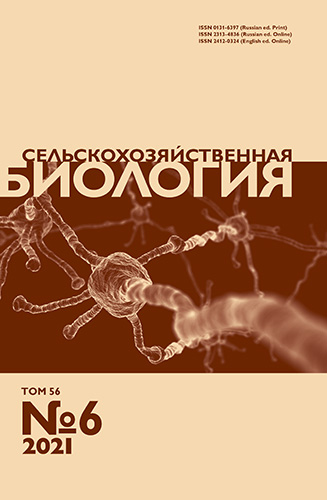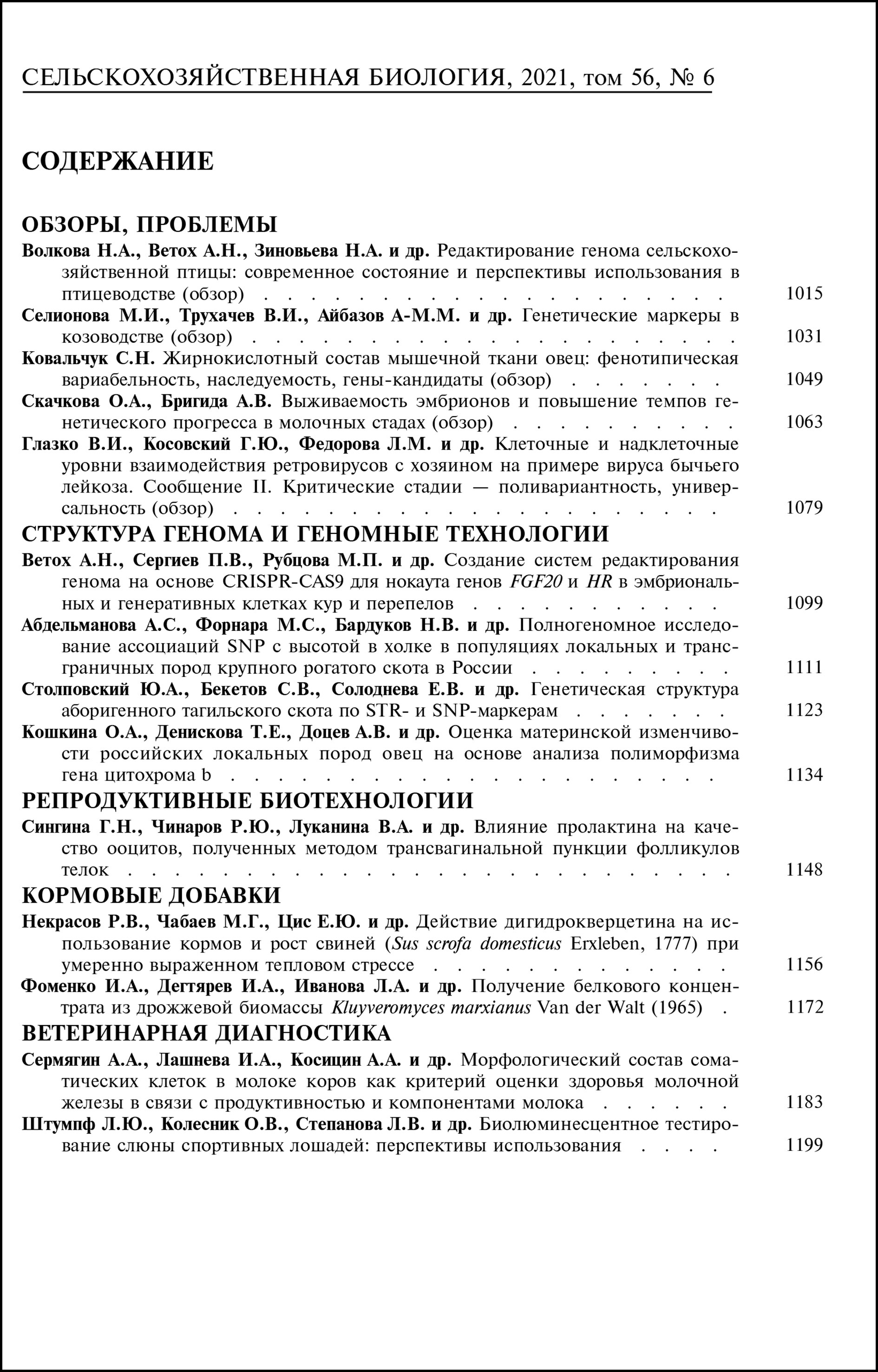doi: 10.15389/agrobiology.2021.6.1049rus
УДК 636.32.38:636.082:577.21
Работа выполнена в рамках Государственного задания Минобрнауки России № ААА-А19-119051590015-1.
ЖИРНОКИСЛОТНЫЙ СОСТАВ МЫШЕЧНОЙ ТКАНИ ОВЕЦ: ФЕНОТИПИЧЕСКАЯ ВАРИАБЕЛЬНОСТЬ, НАСЛЕДУЕМОСТЬ, ГЕНЫ-КАНДИДАТЫ (обзор)
С.Н. КОВАЛЬЧУК ✉
Овцеводство вносит существенный вклад в мировое производство продуктов питания. Одно из актуальных направлений усовершенствования пород овец — улучшение биохимических показателей мяса, что обусловлено изменившимися требованиями к качеству продуктов питания, в частности к их диетическим свойствам. Жирнокислотный состав мяса — важный показатель его качества. Известно, что высокое содержание насыщенных жирных кислот в рационе человека повышает концентрацию холестерина в плазме крови и увеличивает риск развития сердечно-сосудистых заболеваний, диабета и ожирения (A.P. Simopoulos, 2001; F.B. Hu с соавт., 2001). Кроме того, жирнокислотный состав мяса влияет на его потребительские свойства, такие как вкус, аромат, сочность, нежность мяса и усвояемость жира. В связи с этим актуально выявление и использование в селекции генетических маркеров, связанных с жирнокислотным составом мяса овец. В настоящем обзоре проанализированы и обобщены результаты исследований фенотипической вариабельности и наследуемости показателей жирнокислотного состава мышечной ткани овец, в также данные о генах-кандидатах, выявленных с использованием полногеномного поиска ассоциаций (genome-wide association studies, GWAS), основанного на технологии ДНК-чипов (R. Bumgarner, 2013), и метода высокопроизводительного секвенирования РНК (RNA sequencing, RNA-seq), с помощью которого изучают генетические механизмы формирования фенотипов на основе сравнительного анализа профилей экспрессии генов (A. Oshlack c соавт., 2010; K.O. Mutz c соавт., 2013; R. Stark c соавт., 2019). Установлено, что количественные показатели жирнокислотного состава мяса овец разных пород и степень наследуемости этого признака широко варьируют, что указывает на возможность изменения профилей жирнокислотного состава баранины посредством использования генетических методов при селекции (E. Karamichou с соавт., 2006; H.D. Daetwyler c соавт., 2012; S.I. Mortimer c соавт., 2014; S. Bolormaa c соавт., 2016; G.A. Rovadoscki с соавт., 2017). Суммируя результаты GWAS и RNA-seq, можно выделить наиболее значимые гены-кандидаты, вовлеченные в метаболизм жиров и жирных кислот и ассоциированные с внутримышечным содержанием жирных кислот у овец: acot11, baat, pnpla3, lclat1, isyna1, elovl6, agpat9, me1, acaca, dgat2, plcxd3, fads2, scd, cpt1a, pisd, lipg, b4galt6, acsm1, acsl1, aacs и fasn, кодирующие ферменты метаболизма жиров и жирных кислот; гены белков-транспортеров жирных кислот и жиров FABP3, FABP4, FABP5, SLC27A6, APOL6и COPB2, а также гены mlxipl, ppard, wnt11, foxo3, tnfaip8, npas2, fndc5, adipoq, adipor2, trhde, cidec, ccdc88c, tysnd1 и sgk2, которые кодируют транскрипционные факторы и эффекторные белки, регулирующие энергетический и жировой обмен (X. Miao с соавт., 2015; S. Bolormaa с соавт., 2016; L. Sun с соавт., 2016; G.A. Rovadoscki с соавт., 2017; R. Arora с соавт., 2019). Эти данные позволяют глубже понять генетические механизмы, лежащие в основе изменчивости количественных показателей жирнокислотного состава мышечной ткани овец, что послужит необходимой научной базой для разработки успешных селекционных программ в овцеводстве.
Ключевые слова: овцы, жирные кислоты, генетические маркеры, GWAS, RNA-seq, SNP.
S.N. Kovalchuk ✉
Sheep husbandry contributes significantly to global food production. Improving the biochemical parameters of meat is one of the urgent goals of sheep breeding programs due to the changed customers’ requirements for food quality, in particular its dietary properties. The fatty acid composition is one of the important indicators of meat quality. High concentrations of saturated fatty acids in the human diet are known to increase plasma cholesterol concentrations which increases the risk of developing diabetes, obesity, and cardiovascular disease (A.P. Simopoulos, 2001; F.B. Hu et al., 2001). Improving the dietary properties of sheep meat by breeding animals with the increased content of unsaturated fatty acids is one of the possible measures that could reduce the incidence of these diseases. In addition, intramuscular fatty acid composition affects flavor, aroma, juiciness, and tenderness of the meat and the digestibility of fat. These reasons determine the relevance of identifying genetic markers associated with intramuscular fatty acid composition in sheep and their use in sheep breeding programs. This review analyzes data on phenotypic variability, inheritance of the intramuscu-lar fatty acid composition in sheep, and candidate genes identified due to genome-wide association studies (GWAS) with DNA microarrays technology (R. Bumgarner 2013) and high-throughput RNA sequencing method (RNA-seq) applicable in studying genetic mechanisms that are involved in the formation of animal phenotypes at the gene expression level (A. Oshlack et al., 2010; K.O. Mutz et al., 2013; R. Stark et al., 2019). Research results demonstrate that the quantitative indicators of the intramuscular fatty acid composition in different breeds of sheep and the degree of heritability of this trait vary widely which indicates the possibility of changing the profiles of the fatty acid composition of mutton through the use of genetic methods in sheep breeding programs (E. Karamichou et al., 2006; H.D. Daetwyler et al., 2012; S.I. Mortimer et al., 2014; S. Bolormaa et al., 2016; G.A. Rovadoscki et al., 2017). Summarizing GWAS и RNA-seq results, the most significant candidate genes associated with the fatty acid composition of sheep meat are i) acot11, baat, pnpla3, lclat1, isyna1, elovl6, agpat9, me1, acaca, dgat2, plcxd3, fads2, scd, cpt1a, pisd, lipg, b4galt6, acsm1, acsl1, aacs,and fasn which encode the enzymes of fat and fatty acids metabolism; ii) the genes encoding fatty acid transporters FABP3, FABP4, FABP5, SLC27A6, APOL6, and COPB2; iii) mlxipl, ppard, wnt11, foxo3, tnfaip8, npas2, fndc5, adipoq, adipor2, trhde, cidec, ccdc88c, tysnd1 and sgk2 genes which encode the transcription factors and effector proteins, regulating energy and fat metabolism (X. Miao et al., 2015; S. Bolormaa et al., 2016; L. Sun et al., 2016; G.A. Rovadoscki et al., 2017; R. Arora et al., 2019). These data allow a deeper understanding of the genetic mechanisms underlying the phenotypic variability of intramuscular fatty acid composition in sheep, which is a necessary background for successful selection strategies in sheep husbandry.
Keywords: sheep, fatty acids, genetic markers, GWAS, RNA-seq, SNP.
Институт инновационных биотехнологий |
Поступила в редакцию |












